The “lesser” Riviera: the Camargue to Le Lavandou
This is a longish-form piece (3,500 words) of old-style travel writing (personal and information stuff intermingled) about a fortnight’s tour and stay on the French Riviera from the Camargue to Le Lavandou (via Arles, Marseilles, Cassis, and Aix-en-Provence, etc).
From Arles to Cassis
A week into our exploration of the “lesser” Riviera – from the Camargue to Le Lavandou – we are at our base in Cassis and very happy to have decided on this holiday. (I have two new French grammars from Bescherelle and should be able to conjugate “to have decided” quite soon.) I am full of a Saturday lunch at Chez Gilbert, a quayside founding member of la Charte de la Bouillabaisse, where we had the almost obligatory four-fish stew and its accompanying soup (more of which a little later, since it bears repeating, but suffice to say that even French inquirers reeled when a waiter told them the cost involved).
Starting from the west, in some ways the Camargue is an improbable introduction to the fantastic limestone excitements of the bulk of the Riviera. It is, of course, flat and marshy. We took a hot boat trip up the little Rhone and were glad of the overview it gave us, sitting down and all. The bird reserve was also fabulous: easy to get to and enjoy, with a very nice buvette where one could watch herons doing some unexpected exhibitionism, as though they were channelling shags or cormorants, and do so in shade with a bottle of water. The girl running it was pretty, as is only normal for these parts. But she smiled at first blush, and that was very rare, in this land where waitresses mostly first stake their claim to have an existential crisis which outranks one’s own, and then – variously and not invariably – lighten up as acquaintance unfolds. The flamingos were everything one could hope for: glamorous, numerous and close to the paths, which were mostly blissfully short.
A surprising star of that day was the resort town of Saintes Maries de la Mer. Sneered-at by the guide books, it is quite quaint in places and cheerfully modern in most. Along its promenade unpretentious people, mostly not young, do those things which the over-weight and under-dressed people of the west do: smile at the world and enjoy themselves, often with some bling. In the market and streets there are all the tat and the occasional finds one could hope for. I had a lovely swim in a shallow, artificial bay.
Best of all, perhaps, was a 10 Euro paella. This is rice country and our dish tasted as it should: the grains steeped in the cooking liquor and the suspicion of scrapings from the bottom of the pan. Any of the dozen terraced joints along the main drag of the pedestrian quarter would have done as well, probably. The waitress was inefficient to a degree and was one of only two in our first week who couldn’t crack any class of smile. She had Bosnian dentition and too little else to recommend her for this glumness to seem a wise strategy.
Rather more chic, the Saturday market in Arles had strong farmer’s market overtones, and a plausible young man sold us more cheese than we wanted from his glamorous, understated stall: £25 for less than a kilo’s weight of lovely stuff. I seethed, but I don’t think we were ripped-off, and though I felt hussled I may merely have been out of my shopping league.
Arles, the gateway to the Camargue, is a great – a really great – place to visit. Our two nights there were in the Best Western, right in the centre of town, with its own underground parking and a terrace swimming pool looking over the lovely rooftops of the town. Without going into either, we poked about the perimeters of the Roman theatre and the nearby amphitheatre. Both are astonishingly evocative, but the lovely surprise was to find that the whole centre of town – all lovely in its own right – is casually littered with Roman bits and pieces. A riverside walk here is strongly recommended, though at night it has shades of the noir which more usually attaches to Marseille. In the lee of the amphitheatre, at La Fuente a friendly, quietly busy waiter, somehow almost paternal, delivered affordable real cooking to a pretty room, and at Hostellerie des Arenes, a very agreeable and chic waitress brought us bull stew, an important bit of terroir hereabouts, in a stunning location. (By the way, whilst away for weeks, and for quotidian eating, we aim at spending less than £50 per proper sit-down meal for two, and seldom drink much or eat pudding in the achievement of the plan. Just to give you an idea of the class of place we can sort of manage.)
I have been cooking a real pleasure in antiquities, and Arles delivers plenty. Even so I had not expected the casual glories of the archaeology museum on the edge of town (with great parking). Its maquettes re-awaken one’s childish delight in history, and one of them shows how the town used to handle marine and river trade. Its statues remind us how far the Romans had got in portraiture: the faces speak, and some cry out, with a confidence which seems to say that both sitter and artist were sure that their works would endure.
Later, Marseilles had a strong antiquities offer. Its new history museum, with a simple garden whose bones are classical quayside remains, and even the nearby rather ditsy museum which almost literally enshrines the remains of a dock warehouse in situ were both stand-out. By the way, everyone we met in museums was friendly, staff and fellow-tourists alike, and obliging.
It doesn’t much matter, but the show in Marseille’s Mediterranean Villa gallery – new for the city’s Year of Culture gig – was comically inadequate. It was a collection of ho-hum videos which reeked of half-baked brain-storming in a provincial media studies department. It bolstered my determination not to waste feet and back ache on any other art galleries, new or old, in the city. Instead, I slipped into the city’s old bourse, right next to the Old Port and the central tourist information office. And found a gloriously rich, neglected, merchant navy museum which I had all to myself.
Marseilles has a huge amount else going for it. Its market streets are strongly Levantine and its boulevards properly mighty, with some great modernist blocks (bleakly massive but often with inviting colouring and nifty flourishes, as witness those in the deuxieme quartier west of the Old Port, in streets running down to Fort St Jean (whose nearby quays have been refreshed for the year of culture, not least with excellent underground parking). All that sort of leads one to visit what the maps call Le Cité de Corbusier and buffs call Cité Radieuse.
Curiously, after seeing other grand, but older, modernist housing blocks in Marseille, le Corbusier’s effort seems to make quite a natural progression. With its profusion of balconies, it also seems even more humane and democratic than its forebears. I’m afraid I’m a sucker for brutalism and adore concrete. (I forgot to mention this to our neighbour at lunch in Cassis: as we wolfed down the best fish soup I’ve ever had, of which more soon, he was quietly proud of the 128 cement trucks he had in Lyon.)
I don’t think it is quite the case, and something similar might be said of Toulon, but Marseille seems like the essential energiser and stiffener to this Riviera – even more so than is Nice to the terrain further east. Here in Cassis, for instance, there is a workmanlike rush-hour as people hustle between the two, in a din on the lovely D559 which happens to run a hundred feet below our (shut) windows. And Marseille’s people seem to seek out the calanques and hills, and Cassis’s restaurants, much as Lisbon’s go to Estoril and nearby headlands, or Londoners go to Brighton and the Downs, or to Eastbourne, Beachy Head and Cuckmere.
There is a lot to be said for massive, pale structures in this region. Running east from Marseille to Cassis along the brief, twisting run through the hills of the Geneste, on that D559, one is stunned by the scale, the toughness, the vigour of the geology – and the vivid tenacity of the flora clinging to it. These hills are the perfect frame for modern concrete as they are for ancient marble. And as if the Geneste aren’t enough, charming, picturesque, touristy Cassis is at the heart of astounding stone. That it is all bathed in sunshine doesn’t soften it a bit, but adds a sort of bite. As does the Mistral, which knocked several degrees off the bathing water temperature in a very few days.
Week Two: Cassis and westward
We had had (past plu-perfect?) tasty €10 moules in a cafe in the Old Port, in Marseille, in a place so amiable (with handsome, skinny and suave staff) that it didn’t much matter that the dish was wildly over-salted. “They come from the sea, so they are salty”, said the waitress, tartly, or was it primly? But she added that she’d mention it to the chef. And so they take away, before giving back.
The next time I was even slightly difficult with staff was at Chez Gilbert, in Cassis. On the Richter Scale of awkwardness you might think it woossy. Barely a flag-stir on the Beaufort. Still. We were at a terrace table, nicely shaded. Our waiter, who, like all the brigade at this place, was confident, friendly, not into posing or alienation, but attentive and diligent, had brought me a Coke, as I had asked. (He was tall, with a shaven head, black shirt and trousers, and a deep tan.) It was early on in one of the most expensive simple dining encounters in my life, and – with what remained of my edginess on such a blissful day – I didn’t spot that the label did not say “light” or “diet” or “zero”, as I had asked. I poured some, sipped and considered. I called the man over and pointed out the error. The result was highly satisfactory. He said sorry, whipped the offending American cultural totem away, and brought me the right thing. But, oh, the joy of the fallout as everyone from the plongeur to the manager was bad mouthed by our server for allowing so crass a mistake. It was very nearly, just fleetingly, possible, in my enflamed imagination, that he was angry at them for the indignity imposed on me rather than on him. I had become a citizen of the world. No Roman emperor, not the local heroes Augustus or Caesar, nor a superyacht rental customer, had such easy command of their circumstances. My partner said that there was a note of Basil Fawlty about the affair, which took the wind out of my sails: but if it’s true, this was John Cleese channelling Tony Soprano.
I do not say that Chez Gilbert make the best bouillabaisse on the forty-mile strip of Mediterranean where it rules as the signature dish. I am not qualified to judge. But I can say that I have never had so unctuous and manly a fish soup, nor so piquant a rouille, not such lightly crunchy croutons, and I have had plenty of all those. I am pretty sure the St Pierre, rascasse, rouget and lotte were all beautifully cooked: they were certainly firm and delicious.
If you are not rich, and not blasé, and have public school slightly hippy hang-ups, paying €100 for fish soup and stew for two is a moment. When you enter on such an enterprise, you are wise to earmark £150, nibble it on the lobe, and kiss it goodbye long before you enter the restaurant. That way, you have had the pain and earned the pleasure, which then becomes unsullied. I’m just saying, and these things do matter when under the froth of one’s displayed cappacino, there is the hidden severity of puritan espresso.
Cassis attracts a few super-yachts (which cannot fit into its lovely harbour) and plenty of motor-homes. But it is not for the faint-hearted. At best, even in September, you are only likely to find a car park a kilometre or more from the harbour. (Tip: research the local buses and tourist shuttles from Les Gorguettes, the free parking out of town.) Almost everyone has a knapsack. It is not a snobby place, though you may spot the occasional cool person and even the odd exquisite. What with the toned and honed hikers, of all ages, who are leaving for or relaxing after the rigours of the Calanques, and the nearly universal schlepp to and from car-parks, the place is infused with walkers . This is where diamante flip-flop meets dusty Vibram sole, and either is to be found in the other’s more usual environment.
For my part, I had lugged a blow-up kayak to Cassis, and hefted it further, down a path and steps, to the most inland point of the town’s Port Miou.
Paddling one’s own boat down to the sea and round a headland or two to explore the Calanques, which are dauntingly lovely mini-fjords, was a great luxury. It could, mind you, have been done for less than €50 from the kayak-renter on Cassis’s town beach, where I had the most glamorous of swims before and after lunch at the Yacht Club, which is open to all and used by all sorts of visitors and locals seeking refuge from the charming but intense town-side of the port.
Every driver in Cassis, whether using a moped or a Mercedes (some have both in their driveway), is eyeing up a niche, like gannets on a cliff-face. You get with that programme or you go under: you gird your loins and ready your elbows and wing-mirrors, and assert your place in the toing and froing, and then suddenly you get where you want, and there is solitude or laughter, according to the perch you have sought.
Quite aside from the Calanques, you are likely to try out the Routes Des Crêtes towards La Ciotat and be quite frightened by the cliff-top edges which are easily accessible from large car parks. For further stony excitements, the pirouetting D2 east of Gémenos ought to be enough for all but the hardest nuts.
I have walked a good bit whilst here. And the fact is I have had a lot to think about as I recreate miniature travels without a donkey. I can say that the Romanesque has infused our trip. I am an unabashed fan. I am with John Pawson and all the others who like the minimalism of the Cistercian aesthetic, but it is rendered ripe – fully-human, furtively decorative – by the roman-style flourishes on the columns of its cloisters. We had had a giddy, intense warm-up to southern treats in Burgundy. At Fontenay there is a Cistercian monastery with later additions, but its heart and spirit intact. In situ, but perhaps especially in its the exquisite museum, one can get close to the animals and verdure and patterning that make the Romanesque so expressive and satisfying.
In Arles, in the rather beaten-up cloister of the main church, there were some touching remnants of some classy 12th Century pieces, now being restored. In the museums of Arles and Marseille, one sees the original inspiration, of over a thousand years earlier. But there were also the pots, some Greek, some Roman, which sport the shapes and patterns which inspired Picasso’s pottery. We had seen many of these in Antibes (where I first had a delicious bargain-basement fish stew on the quayside where I also first saw Picasso’s pots and drawings over thirty years ago) and in a show at the Royal Academy. Still, to see his work in Aubagne, a pottery town near enough Arles for his bull-fighting scenes to resonate, was wonderful. The show was a temporary one, but it is worth mentioning, I hope, because I am keen on the general point that from the Phoenicians to Picasso, and from the Cistercians to le Corbusier, this rocky, salty place seems all of a piece.
After the intensity of Marseille and its fallout, one might say, in Cassis, it is a soothing pleasure to go eastward to the lesser resorts. We swept past Bandol, which is the busiest of the micro-ports roundabout, and the brashest and perhaps the most bustling. I find it easy to imagine developing a really soft spot for Sanary-sur-Mer: a lovely municipal garden with a water feature which would give the Alhambra a run for its money; a decent, low-key market (free of most of the farmers’ market chic which is both the excitement and almost the bane of those “better” ones such as at Arles). And at Sanary, where there are retirees galore, there is also the faint remembrance of authorly emigrees who sought it out before the war (rather as Charlotte Salomon and plenty of other Jews sought out Nice).
It is Hyeres which most glories in its past. It is a lovely medieval village, set back from the sea – from which it is isolated by salt marshes and a handsome Naval airbase – and beautifully backed by grander, later houses and terraced gardens, to be found up steep staircases and alleys. One of these, St Bernards, is less grand than the hanging gardens of Monaco, but is a heavenly, exotic, arboured retreat. Edith Warton’s house is still there, but is given over to national park offices and now looks always to have been (conjugate that if you please) an unlovely pastiche anyway. I made the pilgrimage because Wharton is a hero of mine, and mention of her allows to me to repeat one of my few good jokes and I think my only literary one, namely that of her and friend Henry James, it was she who had the balls.
I didn’t look for Robert Louis Stevenson’s two addresses in the town, and from which – for all I know – he wrote to Henry James, in their mutual admiration club. Anyway, he loved the place, a fact which makes me warm to it even more. He lived for a while in an Hyeres hotel. I am hoping it was merely typical of one of the town’s great attractions: the really big 19th Century houses along the main drag, because we did see some of them and didn’t seek out his.
In the main square of Hyeres, I realised why I find France such a drag at mealtimes. It is fine if you want to eat well and pay £20 a head or more, or much more. But in Hyeres’ pretty and touristy old town area, we found a good snack bar with terrace. And there, my dears, I had a sort of super-croque made with Poila?ne. This is a bread so posey it is not merely an homage to peasant grey baking, but requires stale bread in its making; it is so artisanal it is branded worldwide. It is delicious and if I were a Hollywood star, I expect I would have it flown in as some of them do. And there it was, in the sort of place I might just about have eaten in whilst doing the vendange, thirty-some years ago, the memory of which makes me pause whenever when I see it going on, as it is as I write in late September.
Whilst we are on about friendly squares, I would say one should go to that at St-Cyr-sur-Mer, set back from the sea, and guarded by a model of the Statue of Liberty. There, I asked in a cafe about a pastry for tea and was invited to buy one from a boulangerie en face, and bring it back to my table. Oh, the bliss of that.
I nearly swam at Le Lavandou, which is a nice, proper resort, but went on to little, and easefully commonplace Cavaliere, where there’s abundant parking, a really good big beach and no hassle. I felt that I could have dropped anchor there for much longer, even an entire low-key holiday. If I had had more strength I don’t doubt I would have tried the steep descents to the several coves between the two more built-up spots.
Having done Marseille, we left Toulon in peace, and felt a little ashamed. On the other hand we did do Aix-en-Provence and it came to the hand very nicely via the little train which saves your legs and feet by hauling your aching arse on its child-sized seats through many of the city’s simply glamorous streets, large and small. There, in a new shopping mall, we found an H&M and two, yes two, brilliant snack bars, full of the kind of people who remind us that this is a real town. One gorgeous man – with that light touch of the moor which makes the Mediterranean – sported various women and eight children, any few of whom might have been his. The whole tribe was almost gypsy in their freedom, but bohemian might be fairer, considering the elegance which lay just beneath their carelessness. And nearby, three of those make-up counter girls, paid to be as painted as geishas, smoked prodigiously over their 8 Euro formules. Whilst sitting there, we read in the local paper that Aix is developing a fashion for food trucks in the American manner. Way to go.
And then to Silvacane Abbey, to remind ourselves of the minimalist underpinning of our trip. It is probably the least dramatic of Provence’s three great Cistercian monasteries. But that is like saying it is the least of Paris, New York or London.
Only on our last day did La Ciotat get its chance, and grabbed it.
Near to Cassis and as different as chalk from cheese. It has massive, but earthen cliffs. It has rundown shipyards with the kind of cranes you see in Belfast, which glowed with a flamingo-pink in the setting sun. Its side streets are more run-down than I had seen anywhere on this coast. Its municipal gardens where a lovely haven: well this side of neglected, they were nonetheless bearing rather welcome signs of being both well-used and under-funded. This is where superyachts come to get fixed or to while away down-time. But there are signs of rejuvenation, too, and they are cheering, even for someone who was enjoying the great ordinariness which La Ciotat seems to be anchored to. That being said, it won’t be a surprise that we ate in a friendly Moroccan place on the harbour-side, though there were a few sprauntsy places with glowing reviews on Trip Advisor. It has, by the way, taken me a long time to calibrate that site’s advice: it surprises me by being much more Michelin than Rough Guide.
And so, homeward, via Chablis, Challon-sur-Saône, and Rouen – of which more later I hope.
ends
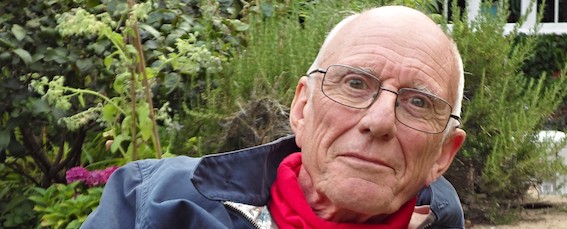

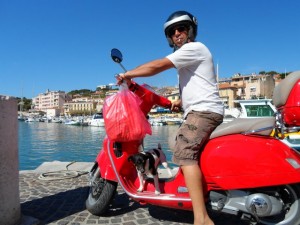
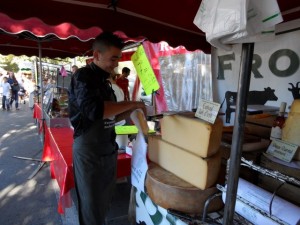
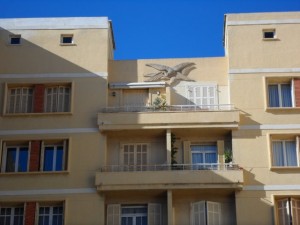
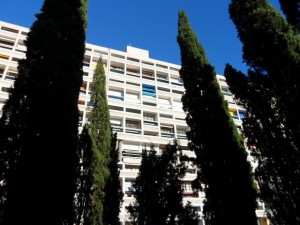
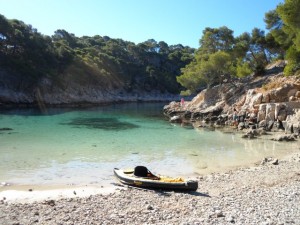
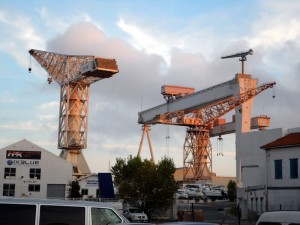
Leave a comment